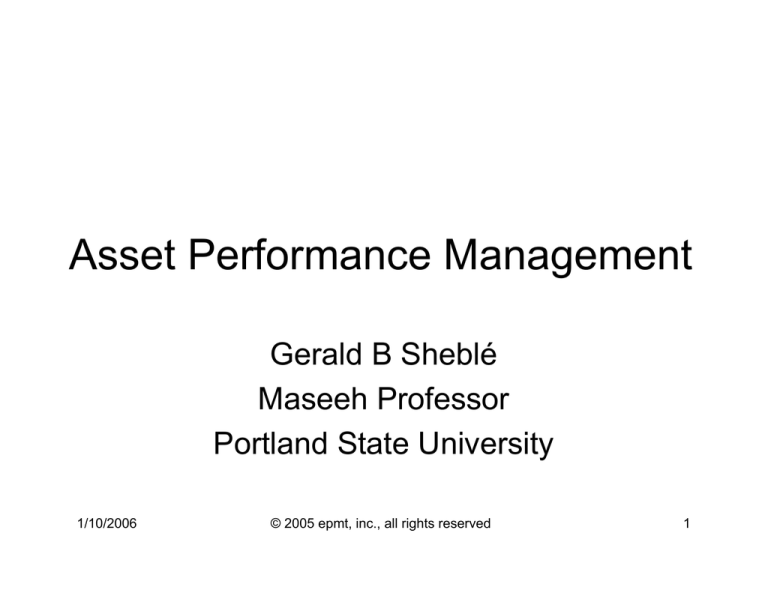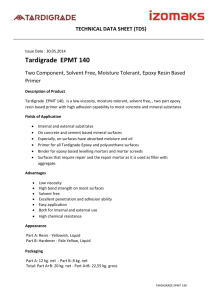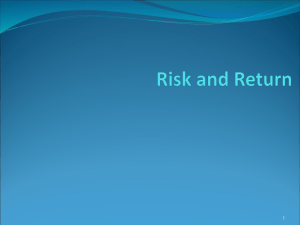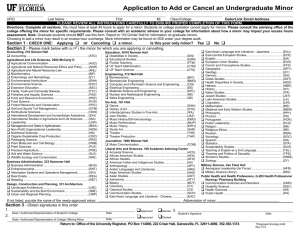
Asset Performance Management
Gerald B Sheblé
Maseeh Professor
Portland State University
1/10/2006
© 2005 epmt, inc., all rights reserved
1
Asset Management
•
•
•
•
•
•
Replace poles before failure
Maintain transformers before failure
Replace insulators before failure
Maintain tree trimming before failure
Maintain inventory of spare transformers
Etc.
1/10/2006
© 2005 epmt, inc., all rights reserved
2
Equivalences
• Asset Management
– Maximize profit within contract constraints
– Subject to sufficient cash flow
– Subject to time horizon
– Without taking significant risk
• Risk Management
– Limit losses
– Mitigate potential losses
1/10/2006
© 2005 epmt, inc., all rights reserved
3
Supply Chain
• Fuel resource
– Coal, oil, natural gas, wind, water, etc.
• Transportation to conversion facility
• Conversion to electricity – GENCO
• Transportation to customer site –
TRANSCO and DISTCO
• Customer use
– Light, heat, movement, communication,
analysis, etc.
1/10/2006
© 2005 epmt, inc., all rights reserved
4
Other Supply Chains
• Natural gas pipelines
– Connect NG to customer application
– Storage, limited
• LNG, CNG
– Global connection for NG
• Oil pipelines, and truck delivery
– Storage, limited
• Wind, hydrogen, biomass, etc.
– Distributed generation
1/10/2006
© 2005 epmt, inc., all rights reserved
5
Selection of Supply Chain
• Customer buys commodity
– Heat – (electricity, natural gas, oil, coal,
hydrogen, wood, etc.)
– Lights – (electricity, ?)
– Movement – (gas, oil, hydrogen, biomass,
diesel or other petroleum based fuels)
– Cooling – (electricity, natural gas)
– Customer can store some of these on site
especially in the hydrogen economy with fuel
cells
1/10/2006
© 2005 epmt, inc., all rights reserved
6
Timing of Selection
• Customer can alter the time table of
consumption
– Cold storage
– Heat storage
– Fuel storage
– Compressed air
– Hydrogen generation
1/10/2006
© 2005 epmt, inc., all rights reserved
7
Company Position
• Framework for financial audit and corporate
governance, based on economic laws
• Provides ability:
–
–
–
–
–
–
Identify important risks to firm
Classify risks as controllable and uncontrollable
Identify causes
Identify mitigation strategies
Provide measured feedback on changes in risks
Relate changes to management
1/10/2006
© 2005 epmt, inc., all rights reserved
8
Portfolio
• Firm builds a portfolio of assets
– Equipment
– Materials
– Labor
– Customers
• Asset Portfolio Characteristics
– Liquid
– Predictable to build business plan
1/10/2006
© 2005 epmt, inc., all rights reserved
9
Framework Implementation
• Establish business model with value
adding processes and activities
• Determine risk factors and earnings
functions
• Determine loss models (distributions)
• Determine threshold for loss
• Capture excess loss data (filters,
scenarios, etc.)
1/10/2006
© 2005 epmt, inc., all rights reserved
10
Framework Assumptions
• Operational risk measure & control
– must reflect variability of earnings as a result
of losses due to errors and omissions and
control breakdowns or rare events,
– reflecting the two categories of
• (a) high frequency, low impact events that are
expected and cause operation losses and
• (b) low frequency, high impact events that occur
unexpectedly and cause extraordinary or excess
losses.
1/10/2006
© 2005 epmt, inc., all rights reserved
11
Framework
• Integrates a measurement methodology
with the business model
• Firm
– Creates earning potential by buying and
selling a portfolio of assets/commodities
– Creates earning potential by buying resources
(materials and labor)
– Creates earnings by providing services
(production)
1/10/2006
© 2005 epmt, inc., all rights reserved
12
Positions in Supply Chain
• Contracts are the glue between supplier
and buyer at each point in the supply
chain, for each supply chain.
• Contracts form a portfolio.
• Portfolio has to provide a suitable ROI
subject to a constrained risk frontier, as
suitable for a company in the same line of
business, with the same WACC.
1/10/2006
© 2005 epmt, inc., all rights reserved
13
Each Link in Chain
• Each link in the chain is a company that has to
provide a business plan to yield a ROI for the
risk for that business.
• Each company must be able to predict (forecast)
the future vector of payoffs with acceptable
accuracy.
• Strategic strength of each company is it’s
capability to maintain it’s present position in the
link and, with diligence, to improve that position.
1/10/2006
© 2005 epmt, inc., all rights reserved
14
Focus Analysis
• Control of trading floor is extended to
corporate wide handling of contracts
• Contracts
– Procurement (equipment, materials, labor,
etc.)
– Sales (transportation to customer, customer
procurement)
– Contingent contracts (“insurance”)
1/10/2006
© 2005 epmt, inc., all rights reserved
15
Math
• Optimization
– maximize active returns
– minus
– adjusted risk penalty
• Compare-to
– Capital Asset Pricing model (CAPM)
– Arbitrage pricing Theory (APT)
1/10/2006
© 2005 epmt, inc., all rights reserved
16
CAPM
Assume:
(1) All investors are Markowitz mean-variance investors.
(2) Short selling is allowed.
(3) There exists a risk free asset.
(4) Investors share same predictions of means, variances and covariances
Theorem: (Capital Asset Pricing Model)
If the market portfolio M is efficient, the expected
return ri of any asset i satisfies
ri − r f = β i ( rM − r f )
σ iM
where β i = 2
σM
1/10/2006
© 2005 epmt, inc., all rights reserved
17
CAPM Graphic
r
M
rM
x
rf
x
σM
1/10/2006
i
σ
© 2005 epmt, inc., all rights reserved
18
Minimum variance
If ei = 0, then this security has
minimum variance for its expected return.
Hence, it lies on the capital market line
r
M
rM
i
x
x
rf
σM
1/10/2006
© 2005 epmt, inc., all rights reserved
σ
19
Non-minimum variance
If εi = 0, this just increases the variance.
r
M
rM
i
x
x
εi ≠ 0
rf
σM
1/10/2006
σ
© 2005 epmt, inc., all rights reserved
20
Implications of CAPM
You are only rewarded (expected return) for risk
that you cannot diversify away.
Risk is measured by β, not the variance of your asset.
The return on an asset is determined by how it fits
into the market portfolio, not by its characteristics alone.
1/10/2006
© 2005 epmt, inc., all rights reserved
21
Portfolio and Security Risk
We started at the Portfolio Level
Markowitz theory minimized the risk (variance) in optimal portfolios.
At the portfolio level, we measured risk by the portfolio variance.
... and arrived at the Security Level
At the security level, CAPM says risk is given by beta.
In fact, CAPM says beta is appropriate at any level, security or portfolio.
1/10/2006
© 2005 epmt, inc., all rights reserved
22
CAPM Investment Implications
One fund theorem:
Buy the market plus treasury securities.
CAPM helps to evaluate the performance of
assets and funds!
Existing Indices
– Jensen
– Treynor
– Sharpe
1/10/2006
© 2005 epmt, inc., all rights reserved
23
Jensen Index
J is known as the Jensen Index.
x
r
rM
rf
J>0
Security Market Line
J<0
x
β=1
1/10/2006
β
© 2005 epmt, inc., all rights reserved
24
The Treynor Index
r
Compute excess
return per unit
of risk taken.
rM
rf
i x
Slope of this line
x
M
Security Market Line
β
1.00
Treynor Index: =
ri − rf
βi
Treynor index is appropriate for securities, but not portfolios
1/10/2006
© 2005 epmt, inc., all rights reserved
25
The Sharpe Index
r
rM
rf
M
x
x
i
σM
Sharpe Index (Ratio) =
Slope of this line
σ
ri − rf
σi
If fund is efficient, it has the same slope as the capital market line.
Sharpe index is appropriate for portfolios.
1/10/2006
© 2005 epmt, inc., all rights reserved
26
Refinements
• Examples of statistical refinements include
Bayesian corrections and adjustments for
heteroskedasticity and autocorrelations.
• Extract more financial information from the time
series:
–
–
–
–
–
–
Benchmark timing
A priori betas
Analyzing value added
Controlling for public information
Style analysis
Controlling for size and value
1/10/2006
© 2005 epmt, inc., all rights reserved
27
Method
• Analysis steps:
– Performance attribution
– Performance analysis
• Attribution focuses on a single period,
attributing return to each component.
• Analysis focuses on times series of returns
attributed to each component.
• Where is skill and added value found?
1/10/2006
© 2005 epmt, inc., all rights reserved
28
Factors Chosen
• Typically use standard risk-model factors as in
typical investment themes
– Value
– Momentum
– Data known at beginning of period (ex ante)
• Use ex post factors for return attribution
– Data known at end of period
• Beyond manager’s returns attributed to factors
will remain the specific return to the portfolio,
specific asset selection.
1/10/2006
© 2005 epmt, inc., all rights reserved
29
Performance Analysis
• Begins with attributed returns each period,
and looks at the statically significance and
value added of the attributed return series
• This relies on t statistics and information
ratios tot determine statistical significance
and value added.
1/10/2006
© 2005 epmt, inc., all rights reserved
30
Extension
• Next step
• Separate time series into components:
– Average active beta and benchmark return
– Average active beta and deviation of realized
benchmark return from its expectation
– Benchmark timing, deviations of active beta
from its mean.
• First component is not a component of
active management.
1/10/2006
© 2005 epmt, inc., all rights reserved
31
Key
• Balance of profit with risk appropriate for
that industry
• Mitigation of risk with contingent contracts
– Suppliers
– Labor
– Equipment Vendors
– Customers
– Other services
1/10/2006
© 2005 epmt, inc., all rights reserved
32
Advanced Tools
•
•
•
•
•
•
•
Delta (error propagation)
Extreme Value Theory (EVT)
Event studies
Causal modeling
Bayesian methods
Cross-sectional studies
Six Sigma
1/10/2006
© 2005 epmt, inc., all rights reserved
33
Performance Attribution
• Assign returns over a single period to each
factor
• Underlying principle is multiple-factor
model
• Examining ex post, portfolio’s exposure is
known at beginning of period, as well as
portfolio’s realized return and estimated
factor returns over the period.
1/10/2006
© 2005 epmt, inc., all rights reserved
34
Foundation
• DATA
– Cost of production
– Cost of negotiation
– Cost of mitigation
– Transaction costs
– Regulatory costs
– Competitor position
– Cost of analysis
– Etc.
1/10/2006
© 2005 epmt, inc., all rights reserved
35
FIN
Questions?
1/10/2006
© 2005 epmt, inc., all rights reserved
36







